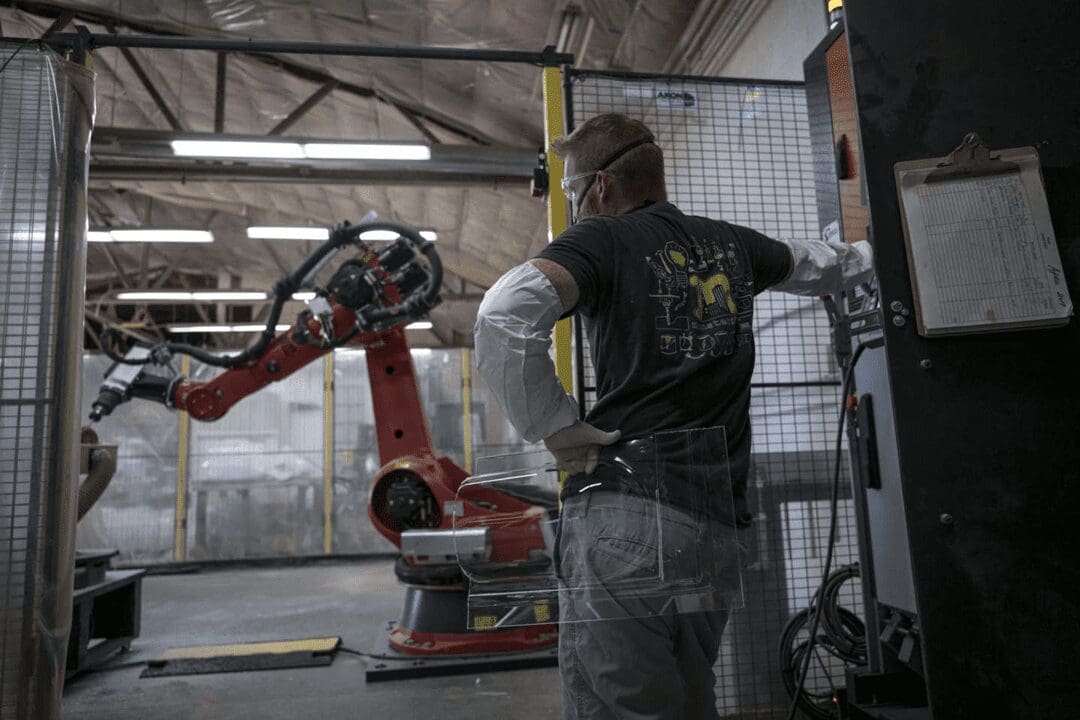Greater automation helped U.S. companies navigate the unprecedented disruption of the pandemic but at what price to workers.
By: David J. Lynch
Greater productivity is the rare silver lining to emerge from the crucible of covid-19. The health crisis forced executives to innovate, often by accelerating the introduction of industrial robots, advanced software and artificial intelligence that reduced their dependence on workers who might get sick.
Even as millions of Americans remain jobless, retailers, food processors, energy producers, manufacturers and railroads all are stepping up their use of machines. Automation may also get a lift from President Biden’s infrastructure plan, which will encourage domestic investment in cutting-edge factories, according to Bank of America.
Employers’ embrace of automation has survived the economy’s move from recession to rebound and is getting new life now that many companies are struggling to attract enough workers to meet surging demand.
Recovery’s stumbles leave Americans facing unfamiliar inflation risk
In Columbus, Ohio, Huntington Bancshares is fielding inquiries from dozens of business customers about financing for equipment purchases, chief executive Stephen Steinour told investors on a recent conference call.
“Universally, they talk about inability to get adequate labor, very high turnover and clear wage inflation at the low end. A consequence of that will be more investment by many of them into automation,” Steinour said.
That attitude has been a boon to companies such as Seegrid, a privately held maker of autonomous forklifts based in Pittsburgh, which saw revenue double last year. By year end, Seegrid, which is profitable, plans to employ 350 workers, up from 150 a year ago, said chief executive Jim Rock.
The e-commerce boom has fueled orders for the company’s self-driving machines — conventional forklifts upgraded with cameras, advanced algorithms and machine learning capabilities. The units lift up to five tons and boast an accident-free track record, he said.
“Business is good. I’m bullish on this year and the next five years,” Rock said.
Advances during the past decade in sensors, wireless communications and optics mean automated systems are increasingly capable. From simple repetitive tasks, they have graduated to complex chores like understanding human voices, deboning chickens and handling chemical liquids.
Greater automation helped U.S. companies navigate the unprecedented disruption of the pandemic. Adjusted for inflation, U.S. productivity has risen by almost 4 percent since the fourth quarter of 2019, nearly twice the increase in output-per-worker over the past five quarters, according to the Bureau of Labor Statistics.
“During the pandemic, firms became more productive and learned to do more with less,” Patrick Harker, president of the Federal Reserve Bank of Philadelphia, said this week.
In the first quarter, business spending on equipment rose at a seasonally adjusted annual rate of 16.7 percent, more than twice as fast as the overall economy, according to the Commerce Department.
Three-quarters of companies surveyed by McKinsey Global Institute last fall said they expect investment in new technologies to accelerate through 2024. If that happens, productivity growth in countries such as the United States could rise by a full percentage point, boosting living standards and more than doubling pre-pandemic trends, according to a McKinsey study.West Virginia factory is center stage in supply chain crisis, showing economy’s strains
Pilgrim’s Pride, a chicken processor based in Greeley, Colo., is implementing a “long-term strategy” of greater automation. The company cut its workforce over the past year by 1,200 people and expects to trim an additional 5,600 jobs this year, chief executive Fabio Sandri said last month.
Likewise, Solaris Oilfield Infrastructure introduced an all-electric automated system that should reduce the number of workers needed on a fracking, or hydraulic fracturing, site by 80 percent, the company said on a recent investor call.
As the economy emerges from a deep recession, output typically recovers faster than the labor market. Today, the outlook is further complicated by structural changes in what consumers are buying and where workers are needed.
Even once the total number of jobs is back to pre-pandemic levels, employment is expected to grow more slowly than pre-pandemic estimates, economists said.
“We don’t have employment getting back on the pre-covid trajectory, ever,” said Gregory Daco, chief U.S. economist for Oxford Economics.
It isn’t that automation is taking jobs from people; it’s allowing companies that can’t find enough workers to fill orders they otherwise would have to turn down.
“You don’t fire workers and hire a robot. That happens exactly no times,” said David Autor, an economics professor at the Massachusetts Institute of Technology.
Indeed, one of the nation’s largest users of industrial robots, Amazon, announced last week that it planned to hire 75,000 new employees for its fulfillment and logistics centers at an average hourly starting wage of more than $17.
The company, which deploys more than 200,000 mobile robots throughout its warehouses, said it will pay signing bonuses of up to $1,000 in some locations. Since the end of 2019, Amazon has hired 500,000 new workers — more than the combined employment of Ford, Caterpillar, and Lockheed Martin. (Amazon founder Jeff Bezos owns The Washington Post.)
Bank of America analysts have dubbed the emerging era of worker-robot collaboration the age of “robo sapiens.” Along with the workers needed to build industrial robots or write code for automated production software, such systems require people to operate, maintain and repair them.
Still, by 2025, the global economy will be populated by twice as many robots as in 2019, meaning workers face years of disruption even after the pandemic is a memory, Bank of America analysts said in a new report. Up to 40 percent of existing U.S. jobs are in categories that are vulnerable to automation, such as office support, food service, production and customer service, they said.
The World Economic Forum last year forecast that automation by 2025 would lead to a gain of 12 million jobs. But that sunny bottom line masked enormous tumult: the elimination of 85 million jobs alongside the creation of 97 million new ones.
There is nothing new about American companies introducing new, more efficient types of technology. The difference now is that the coronavirus pandemic accelerated the introduction of automation in industries that previously had been slow to embrace such systems.
Last year, for the first time, companies outside the auto industry — a traditional automation pioneer — accounted for more than half of industrial robot orders, according to the Association for Advancing Automation, an industry group. The past two quarters were the second and third best for industry orders in nearly 40 years of record keeping, said Jeff Burnstein, president of the association.
Norfolk Southern, a major railroad operator, is rolling out “machine vision technology” to automate rail track and freight car inspections, aiming to “go down the path of more efficient and productive railroading,” chief executive Jim Squires told analysts.
Moderna, the maker of a coronavirus vaccine, said earlier this month that it plans to increase its spending on digital automation and artificial-intelligence investment to $170 million this year, up from $27 million two years ago.
Albertsons has begun a trial of electric delivery robots made by Tortoise, a Silicon Valley start-up, at two of its Safeway grocery stores in California. At Tyson Foods, managers are investing in automation to eliminate “the more difficult and higher-turnover jobs,” Donnie King, the president of the company’s poultry unit, said this week.Republicans are still waiting for the ‘Biden depression’ that Trump promised
The pandemic has kick-started a turn to automation, which will gradually spread through the economy, said Ethan Harris, Bank of America’s head of global economics.
“There’s a breaking of the ice. That’s what recent events are doing,” he said. “It’s not just covid. It’s the trade war. It’s supply-chain concerns. We call it a tectonic shift. It’s a big shift, but it happens slowly.”
Pandemic-inspired structural shifts in the economy are spurring automation. Consumers are buying more goods and services, including medical care, online. Fewer people are likely to work five days a week in downtown office buildings, shrinking demand for all of the businesses that support the traditional commuter model and boosting sales of technologies that facilitate remote work.
The U.S. economy this year is expected to post its strongest growth since the mid-1980s. But beneath the surface, workers will be engaged in a mass migration from industries that no longer need as many workers as they did before the pandemic to those that need more.
Thanks to the growth of e-commerce, warehouses employ almost 6 percent more workers than in February 2020. The leisure and hospitality sector, on the other hand, remains 17 percent below its pre-pandemic level. Although hotels, airlines and theme parks have added almost 1 million jobs in the past three months, the industry’s embrace of greater digitization — such as touchless hotel check-ins — may leave employment depressed.
Many companies, meanwhile, report hiring troubles. Inadequate child care prevents many people, especially women, from returning to work. Lingering fears of being infected on the job keep others away, and the extra $300 each week in supplemental federal unemployment benefits may allow some workers to be patient about reentering the labor market.
Machines don’t have those problems.
“North America labor is very tight,” Lee Banks, Parker Hannifin’s chief operating officer, told investors recently. “So a lot of our customers are doing what we’re doing. Just really using … automation where appropriate.”





















